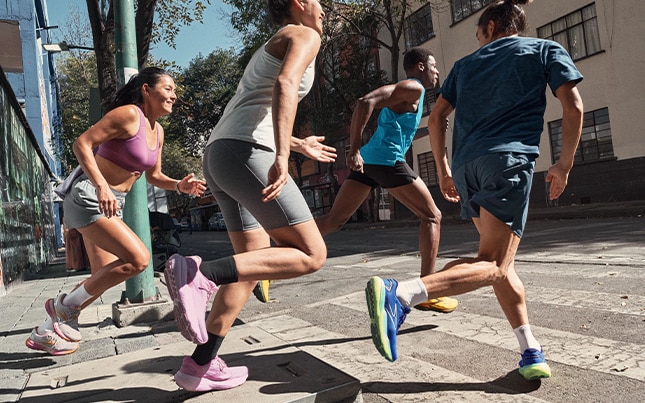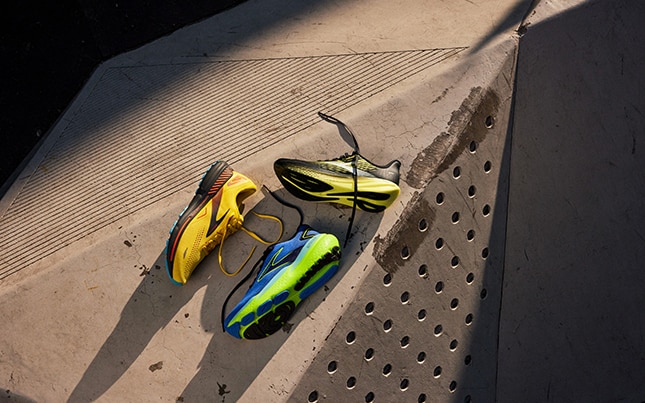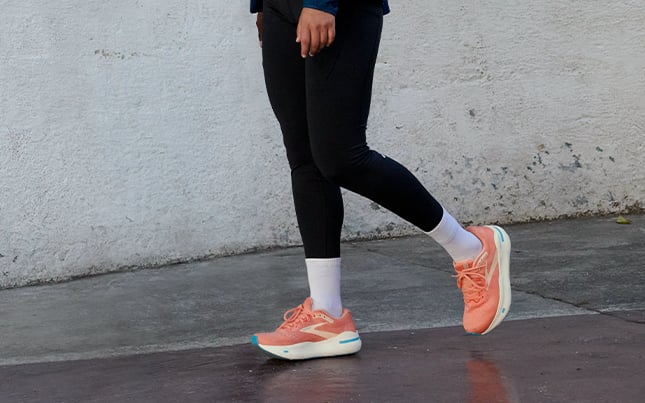Choosing the best marathon shoes: Factors to consider for success on race day

Whether you’re gearing up to run your first marathon or looking to improve your performance in your next race, one of the most critical decisions you'll make as a runner is selecting the right pair of shoes.
The best marathon running shoes should support you with every stride, and our unique selection of running shoes is designed to do just that. From how your foot structure impacts your shoe needs to what features to prioritize and how to break your shoes in before race day, here’s what to keep in mind as you explore marathon running shoe options.

Marathon running shoes designed for the road
When selecting the ideal shoes for running a marathon, it's crucial to consider the terrain you'll be tackling during the race. Different terrains require different features in running shoes to optimize performance and comfort and protect against injuries that can take you out of the race unexpectedly.
Many big city marathons, like the New York City Marathon and the Chicago Marathon, take you on a journey through urban areas. That means you’ll be running mostly on paved roads and cement sidewalks and paths. You’ll want to choose shoes with ample cushioning and support to absorb the impact of the hard surfaces.
Understanding pronation type
Understanding your pronation type is crucial when selecting the best marathon shoes . Pronation refers to the natural inward rolling motion of the foot during each stride. Each pronation type affects how your foot absorbs shock and distributes pressure while running. Identifying your pronation type and selecting shoes that address your specific needs can play a significant role in your marathon training and performance.
There are three main types of pronation:
- Neutral pronation: The foot doesn’t roll significantly in either direction and generally remains neutral. People with neutral pronation can wear a variety of shoe types.
- Overpronation: Overpronation can lead to problems such as pain in the feet, ankles, or knees. Overpronators benefit from shoes with added stability or motion control to correct excessive inward rolling.
- Underpronation (supination): Underpronation means the feet are leaning outward, away from each other. This can lead to excess pressure along the lateral edges of the feet and can sometimes result in strain on the knees as well. Shoes with extra cushioning can help absorb impact and provide support for their outward rolling motion.

Weather conditions
Training and race day are going ahead, rain or shine, so it’s important to be prepared. Weather conditions play a crucial role in determining the best running shoes for marathons . In hot and humid weather, runners may opt for shoes with breathable mesh uppers to keep their feet cool and dry. On the other hand, in cold and wet conditions, waterproof or water-resistant shoes can help protect the feet and provide traction on slippery surfaces. Adapting shoe choice based on weather conditions can enhance comfort, performance, and overall running experience during a marathon.
Brooks shoes that meet your criteria
If you’re in the market for the best marathon running shoes, ideally, you’ll find a pair that meets all your needs. We have a few different lines that are designed specifically for runners and may be the perfect marathon running shoes for you. Remember, it is possible to find all the features you need in a single pair of shoes, so don’t settle for less. Try experimenting with some of our most popular running shoes to find a pair that works for you.
Ask an expert: What should a marathon runner look for in a pair of running shoes?
Like any running shoe, comfort and fit comes first. Throughout a base building and then race-specific training cycle, marathoners spend a lot of time on their feet. I recommend a shoe rotation that includes, ideally, a daily trainer and recovery shoe like the Ghost Max or Glycerin 21, a speed day shoe like the Hyperion Max, which can also serve as a race day shoe. For a carbon plate, another race day option is the Hyperion Elite.
Breaking in your marathon shoes
Any marathon runner knows that wearing a pair of shoes for the first time on race day is a bad idea. From developing blisters to finding that the midsole structure isn’t right for your pronation type, the wrong shoes could end your race prematurely and even lead to injuries.
Breaking in marathon running shoes is essential to ensure they are comfortable and perform optimally on race day. Start by wearing the shoes for shorter runs to allow your feet to adjust gradually. Pay attention to any discomfort, hot spots, or rubbing during the break-in period, as this can indicate potential issues that may arise during a marathon. Evaluate the fit, cushioning, support, and overall feel of the shoes during your training runs and make adjustments as needed, such as trying different lacing techniques or insoles.
Choosing the right shoes is essential for conquering your next marathon. To find the best marathon running shoes for you, don’t be afraid to try on a few different pairs and see how they feel after a couple of miles.
Browse our top shoes for men and women to find a pair of marathon running shoes that can help you achieve a new personal best on race day.
Shop this article
This is a carousel. Use next and Previous buttons to navigate.

CONTRIBUTING EXPERT
Amanda Katz
Brooks Run Happy Team
As a full-time fitness professional, Amanda believes all bodies deserve a safe, shame-free exercise experience. Amanda is an NASM-certified personal trainer, RRCA-certified run coach, and group fitness instructor specializing in cycling, treadmill running, and total body conditioning at Equinox in New York City.
Disclaimer: Our writer's advice is intended for informational or general educational purposes only. We always encourage you to speak with your physician or healthcare provider before making any adjustments to your running, nutrition, or fitness routines.
